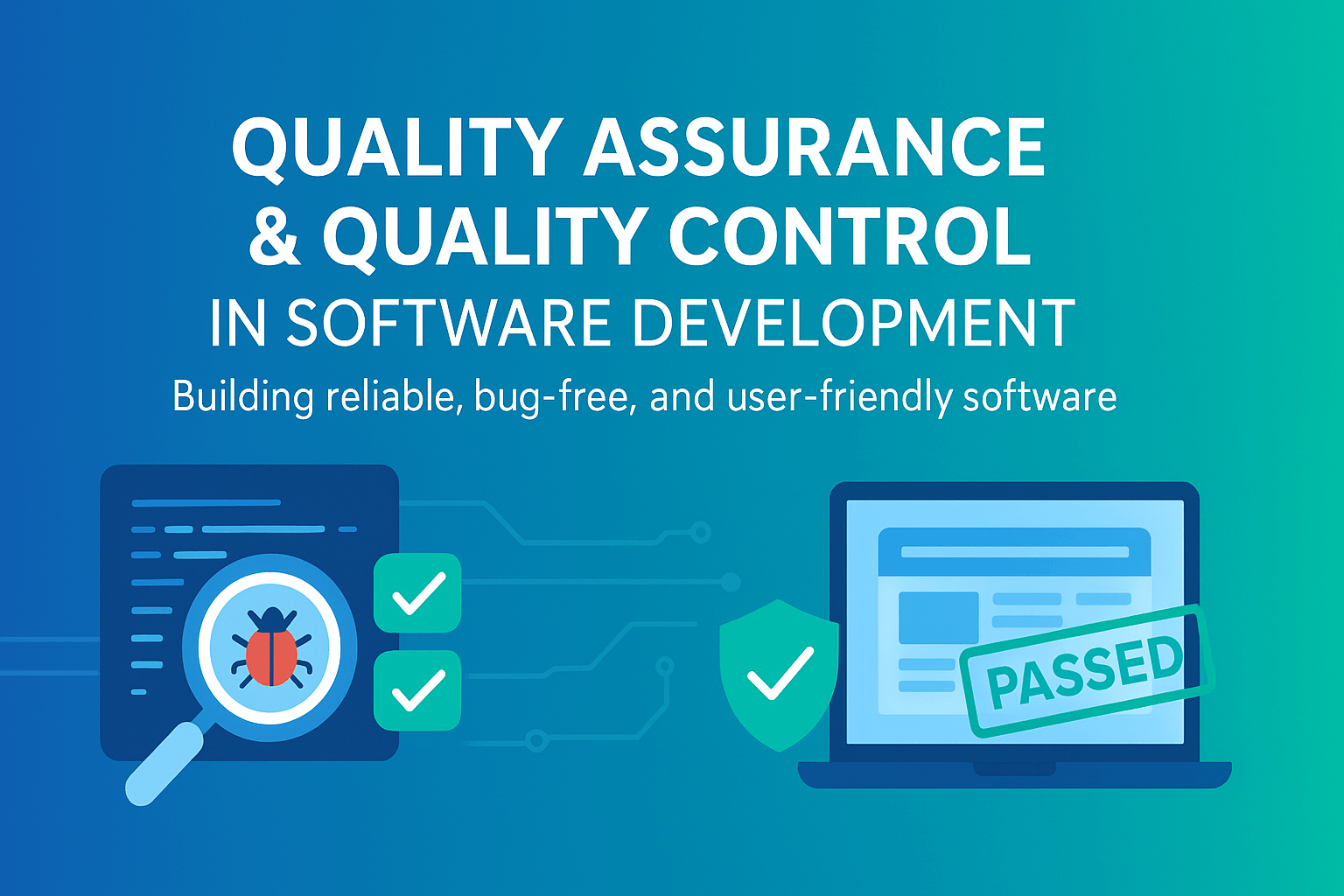
In 2020, a single software glitch cost a major airline more than $50 million in lost revenue and penalties. Similar cases across industries show that undetected bugs are not just technical issues—they directly impact business performance and customer trust. This is where quality assurance services and quality control come into play.
Quality Assurance (QA) is the process of preventing defects by improving the way software is designed and developed. It focuses on standards, documentation, and continuous improvement. Quality Control (QC), on the other hand, is about detecting and fixing defects in the final product through methods like quality control software testing.
Together, QA and QC form a strong defense against costly failures. For IT projects, reliable software QA QC practices ensure that products are released on time, perform well, and meet user expectations.
This blog will explore why QA and QC matter, how they support IT projects, and the best practices companies can use to deliver high-quality software. You’ll also learn how effective QA QC software testing reduces risk, cuts costs, and improves long-term ROI.
Quality Assurance (QA) is a process-oriented approach that ensures software is built the right way from the start. Instead of waiting until the end to catch problems, QA focuses on preventing defects during development. Companies that invest in quality assurance services create stronger processes that reduce risks early in the lifecycle.
Common QA practices include:
By setting standards and monitoring workflows, QA creates a foundation where errors are less likely to occur.
Quality Control (QC) is a product-oriented approach focused on finding and fixing issues in the finished product. Unlike QA, which prevents problems, QC detects them after development through quality control software testing.
Typical QC practices include:
QC acts as the final checkpoint before release, ensuring software meets user expectations and business requirements.
While QA and QC serve different purposes, they are equally important. QA prevents issues through strong processes, while QC detects issues in the product itself. When combined, they reduce defects, cut costs, and increase customer satisfaction.
Relying only on one side can create gaps. Strong quality assurance services without proper testing may still allow defects to slip through, while testing without a defined process may result in recurring errors. Together, QA and QC software testing create a balanced strategy that keeps IT projects on track and delivers reliable results.
Reliable software depends on strong processes during development and rigorous testing before release. Quality Assurance (QA) prevents problems by setting clear standards, enforcing coding practices, and monitoring workflows. This proactive approach reduces the chance of defects reaching production.
Quality Control (QC) plays an equally critical role by catching defects that slip past initial safeguards. Through methods like functional, regression, and performance testing, QC ensures the software works as intended under real-world conditions. Together, QA and QC create a framework where software is both stable and dependable.
Fixing a bug in production often costs several times more than addressing it during development. QA helps identify risks early, ensuring teams don’t waste time and money fixing preventable issues later in the cycle.
At the same time, strong quality control in IT projects minimizes rework and reduces post-release failures. By combining preventive measures with thorough testing, businesses can avoid costly downtime, protect sensitive data, and meet compliance requirements.
End users judge software by its reliability and ease of use. A single defect can frustrate customers and damage trust in the brand. High-quality software, on the other hand, strengthens reputation and increases user loyalty.
Effective QA QC ensures that applications are not only functional but also provide a smooth user experience. By consistently delivering reliable products, companies build long-term customer confidence and stand out in competitive markets.
QA and QC are not standalone steps—they are integrated throughout the Software Development Lifecycle (SDLC). QA begins at the requirements stage by ensuring project goals are clear, measurable, and testable. During design and development, QA sets coding standards and verifies that processes follow best practices.
QC takes over during and after development through structured quality control software testing. Functional, regression, and performance testing validate that the product meets both technical requirements and user needs. With continuous integration and automated testing practices, QA QC becomes a seamless part of each development cycle, reducing the chance of late-stage surprises.
Modern IT teams rely on speed and collaboration, and QA QC plays a critical role in making that possible. In Agile environments, testing is integrated into every sprint, allowing issues to be caught early instead of piling up at the end of a release.
In DevOps, QA QC ensures smooth collaboration between developers, testers, and operations teams. Automated testing pipelines provide faster feedback, making it possible to release updates more frequently without sacrificing reliability. By embedding QA QC into these workflows, teams can balance speed with quality.
These examples show how strong QA QC practices lead to measurable business success, while weak or neglected processes often result in delays, financial loss, and customer dissatisfaction.
A strong QA process starts with setting quality benchmarks that define what success looks like. These benchmarks align with project requirements, user expectations, and compliance standards. Clear metrics allow teams to measure progress and identify gaps early.
Documentation also plays a major role. Well-documented coding standards, testing procedures, and review checklists give teams a consistent reference point. When paired with regular audits and continuous improvement practices, QA becomes more than a checkpoint—it evolves into an ongoing process that strengthens every development cycle.
QC focuses on validating that the finished product meets both technical and business requirements. The most effective approach is to apply multiple levels of testing:
Another key decision is balancing automated and manual testing. Automated testing speeds up repetitive tasks and supports continuous integration, while manual testing is still essential for exploratory testing and user experience validation. Combining both creates a complete quality control software testing strategy.
Modern QA QC practices rely on tools that streamline and automate testing. Popular solutions include Selenium for web automation, JUnit for unit testing, and TestRail for test case management. These tools help teams track progress, maintain accuracy, and handle complex test environments.
Artificial intelligence is also shaping the future of QA QC. AI-powered test automation can predict high-risk areas, generate smarter test cases, and speed up defect detection. As projects scale, leveraging automation and AI ensures that QA QC remains efficient without compromising reliability.
The role of QA QC is evolving as software development demands faster releases, stronger security, and higher reliability. Emerging practices and technologies are reshaping how testing is approached.
Traditional testing at the end of a project is no longer effective. Teams are moving toward continuous testing, where QA and QC activities are integrated into every stage of development. This approach allows issues to be detected earlier, reducing the cost of fixes and ensuring software remains stable throughout the lifecycle.
Artificial intelligence is becoming a key driver in QA QC. AI-powered test automation tools can analyze code, detect patterns, and generate optimized test cases. They also help prioritize high-risk areas, reducing the time spent on repetitive checks. By combining AI with traditional quality control software testing, teams achieve greater accuracy and efficiency.
As software systems handle more sensitive data and serve global markets, QA QC is expanding beyond functional testing. Security testing ensures applications can withstand cyber threats, performance testing validates speed and scalability, and compliance testing confirms alignment with industry regulations. These areas will continue to gain importance, especially in finance, healthcare, and government projects.
The future of QA QC is about speed, intelligence, and resilience. Teams that embrace these changes will be better equipped to deliver reliable software in highly competitive markets.
Conclusion
According to the Consortium for IT Software Quality (CISQ), poor software quality cost U.S. businesses more than $2.41 trillion in 2022 due to failures, outages, and security breaches. This number highlights why software QA QC is no longer optional—it is a requirement for any modern IT project.
Structured QA QC practices reduce risks by preventing defects before release and catching issues through quality control software testing. The results are tangible: fewer delays, lower maintenance costs, and stronger compliance. At the same time, QA QC improves customer satisfaction by ensuring that applications are reliable, secure, and easy to use. For businesses, these gains translate into higher ROI and long-term trust from users.
The companies that succeed in competitive markets are the ones that take quality seriously. Now is the time to invest in proven QA QC software testing strategies and leverage professional quality assurance services to ensure projects are delivered on time, on budget, and without costly surprises.
